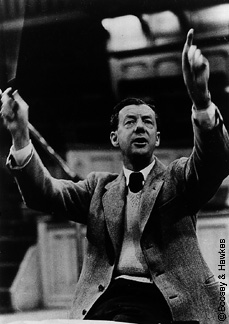Share This:
May 19, 2011 | Theatre,
The Opera inside “Susurrus”
By Jason Rabin
Susurrus weaves a variety of discourses and perspectives together to tell its complex tale, and they all revolve around another piece of auricular adaptation: composer Benjamin Britten’s 1960 opera of Shakespeare’s A Midsummer Night’s Dream, recently performed by the Boston Lyric Opera.

Considered one of the 20th century’s greats, and easily one of the UK’s most celebrated composers, Britten was born in Lowestoft England in 1913 on November 22, the Feast of Saint Cecilia, patron saint of music. It’s said that he started composing, independently, at the age of 5. His storied career spanned from the 1930’s through his death in 1973 in his adopted home of Brooklyn Heights, New York.
Britten is known for musical works of a literary nature. He collaborated with the English poet W.H. Auden, created operas around Herman Melville’s Billy Budd and Henry James’ Turn of the Screw, and based his popular Peter Grimes on the work of poet George Crabbe.
Britten is also known for his devotion to the popular tenor, Peter Pears, a figure referenced in Susurrus. Pears served as co-librettist for Midsummer, and played the role of Francis Flute, the play’s reluctant cross-dressing actor. Off-stage, he became Britten’s muse and his life partner. In looking into Britten’s sexuality, some biographers have pointed to a lifelong fascination on the composer’s part with adolescent and pre-adolescent boys—an important point for our plot.

In addition to Peter Pears, Susurrus makes mention of Dame Janet Baker, another star interpreter of Britten’s music. Known for her talents as a dramatic actress, as well as for her voice, Baker made her professional debut playing Hermia—the rebellious daughter who flees into the wild woods with her lover rather than marry against her will—in Britten’s Midsummer.
As alluded to, the performance was held at the Royal Opera House in Covent Garden, a popular tourist destination in London’s West End, known for its open-air market and its “opera terrace,” in which on any given day, one might be treated to busker’s aria while grabbing a cappuccino.


How does all this opera talk relate to a walk in the Public Garden? Strap on your Susurrus headphones to find out.




Leave a Reply